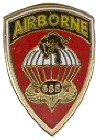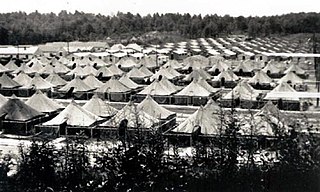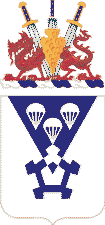This article has multiple issues. Please help improve it or discuss these issues on the talk page . (Learn how and when to remove these template messages)
|
"Blood on the Risers" is an American paratrooper song from World War II. [1]
This article has multiple issues. Please help improve it or discuss these issues on the talk page . (Learn how and when to remove these template messages)
|
"Blood on the Risers" is an American paratrooper song from World War II. [1]
Sung to the tune of the "Battle Hymn of the Republic", the song tells of a fatal training jump of a rookie paratrooper whose parachute fails to deploy, resulting in him falling to his death. Each verse describes the man’s death and the subsequent condition of his body in the aftermath. The chorus mimics the chorus in The Battle Hymn of the Republic, replacing the lyrics "Glory, glory, hallelujah! His truth is marching on." with "Gory, gory, what a hell of a way to die! He ain't gonna jump no more." [2] [3]
The song is a cautionary tale on the dangers of improper preparation of a parachute jump. [4] The protagonist does almost everything right but forgets to hook up his static line which would automatically deploy his main parachute. Upon discovering this error during the jump, he deploys his reserve chute in bad falling position. He becomes entangled in the parachute’s canopy and risers, falls uncontrollably, and dies upon impact with the ground. American parachute rigs during World War II stored the reserve parachute in a belly bag, so deploying it in a bad falling position could easily lead to an accident similar to the one described in the song. "Risers" are the four straps that connect the suspension lines of the parachute canopy to the parachute harness.
The song is associated with all current American airborne units, including the 82nd Airborne Division, the 173rd Airborne Brigade, the 101st Airborne Division and 11th Airborne Division, and the 120th CTS (United States) as well as British airborne units. It is known as "Mancha Roja" (Spanish for "Red Stain") in airborne units from multiple Latin American countries. In Spain it is called "Sangre en las cuerdas" ("Blood on the lines").
This song has been featured in the television miniseries Band of Brothers , the television series Preacher , and the video game Brothers in Arms: Road to Hill 30 . It was also mentioned in Donald Burgett's book Currahee!: A Screaming Eagle at Normandy .
WWII veteran Vincent Speranza was recorded singing the chant in 2019; the video has more than one million views on YouTube as of December 2023. [5] Speranza later recorded his own version of the chant. [6]

A paratrooper is a military parachutist—someone trained to parachute into a military operation, and usually functioning as part of airborne forces. Military parachutists (troops) and parachutes were first used on a large scale during World War II for troop distribution and transportation. Paratroopers are often used in surprise attacks, to seize strategic objectives such as airfields or bridges.

Airborne forces are ground combat units carried by aircraft and airdropped into battle zones, typically by parachute drop. Parachute-qualified infantry and support personnel serving in airborne units are also known as paratroopers.

The 101st Airborne Division (Air Assault) ("Screaming Eagles") is a light infantry division of the United States Army that specializes in air assault operations. It can plan, coordinate, and execute multiple battalion-size air assault operations to seize terrain. These operations can be conducted by mobile teams covering large distances, fighting behind enemy lines, and working in austere environments with limited or degraded infrastructure. It was active in, for example, foreign internal defense and counterterrorism operations in Iraq, in Afghanistan in 2015–2016, and in Syria, as part of Operation Inherent Resolve in 2018–2021.

The 82nd Airborne Division is an airborne infantry division of the United States Army specializing in parachute assault operations into hostile areas with a U.S. Department of Defense mandate to be "on-call to fight any time, anywhere" at "the knife's edge of technology and readiness." Primarily based at Fort Liberty, North Carolina, the 82nd Airborne Division is part of the XVIII Airborne Corps. The 82nd Airborne Division is the U.S. Army's most strategically mobile division.
Operation Golden Pheasant was an emergency deployment of U.S. troops to Honduras in 1988, in response to Nicaraguan attacks on Contra logistics in Honduras.

"John Brown's Body" is a United States marching song about the abolitionist John Brown. The song was popular in the Union during the American Civil War. The song arose out of the folk hymn tradition of the American camp meeting movement of the late 18th and early 19th century. According to an 1889 account, the original John Brown lyrics were a collective effort by a group of Union soldiers who were referring both to the famous John Brown and also, humorously, to a Sergeant John Brown of their own battalion. Various other authors have published additional verses or claimed credit for originating the John Brown lyrics and tune.

The 555th Parachute Infantry Battalion, nicknamed The Triple Nickles, was an all-black airborne unit of the United States Army during World War II.

The 506th Infantry Regiment, originally designated the 506th Parachute Infantry Regiment during World War II, is an airborne light infantry regiment of the United States Army. Currently a parent regiment under the U.S. Army Regimental System, the regiment has two active battalions: the 1st Battalion, 506th Infantry Regiment is assigned to the 1st Brigade Combat Team, 101st Airborne Division, and the 2nd Battalion, 506th Infantry Regiment is assigned to the 3rd Brigade Combat Team, 101st Airborne Division.

A parachutist badge is a badge awarded by armed forces or paramilitary forces of many states to personnel who have received parachute training and completed the required number of jumps. It is difficult to assess which country was the first to introduce such an award.

The Parachutist Badge, also commonly referred to as "Jump Wings", is a military badge of the United States Armed Forces. Some services, such as the Marine Corps, officially refer to it as an insignia instead of a badge. The United States Space Force and United States Coast Guard are the only branches that do not award the Parachutist Badge, but their members are authorized to receive the Parachutist Badges of other services in accordance with their prescribed requirements. The DoD military services are all awarded the same Military Parachutist Badge. The U.S. Army and U.S. Air Force issue the same Senior and Master Parachutist Badges while the U.S. Navy and U.S. Marine Corps issue the Navy and Marine Corps Parachutist Insignia to advanced parachutists. The majority of the services earn their Military Parachutist Badge through the U.S. Army Airborne School.

Camp Toccoa was a basic training camp for United States Army paratroopers during World War II, located five miles west of Toccoa, Georgia. Among the units to train at the camp was the 506th Infantry Regiment. The regiment's Company E was portrayed in the 2001 HBO miniseries Band of Brothers.

The 503rd Infantry Regiment, formerly the 503rd Parachute Infantry Regiment and the 503rd Airborne Infantry Regiment, is an airborne infantry regiment of the United States Army. The regiment served as an independent regiment in the Pacific War during World War II; at Fort Campbell, Kentucky; in Okinawa, Japan; and in Germany. Regimental elements have been assigned to the 2nd Infantry Division, the 11th Airborne Division, the 24th Infantry Division, 25th Infantry Division, the 82nd Airborne Division, 101st Airborne Division, and the 173rd Airborne Brigade Combat Team. Regimental elements have participated in campaigns in the Vietnam War, Operation Enduring Freedom–Afghanistan, and Operation Iraqi Freedom. The regiment claims 15 Medal of Honor recipients: two from World War II, ten from Vietnam, and three from Afghanistan. A parent regiment under the U.S. Army Regimental System. The regiment's 1st and 2nd Battalions are active, assigned to the 173rd Airborne Brigade, based at Caserma Ederle, Vicenza, Italy. The 3rd and 4th Battalions as well as Companies E, F, G, H, and I have been inactived.

The United States Army Airborne School—widely known as Jump School—conducts the basic paratrooper training for the United States Armed Forces. It is operated by the 1st Battalion (Airborne), 507th Infantry, United States Army Infantry School, Fort Moore, Georgia. The Airborne School conducts the Basic Airborne Course, which is open to troops from all branches of the United States Department of Defense, Reserve Officer Training Corps, and allied military personnel.

The 509th Infantry Regiment is an airborne infantry regiment of the United States Army. The unit was initially activated as a single battalion, the 504th Parachute Infantry Battalion, in October 1941 at Fort Benning, Georgia. Nicknamed "Geronimo", the 509th conducted the U.S. Army's first combat jump during World War II on 8 November 1942, flying 1,500 miles from England to seize Tafarquay airport in Oran, Algeria. The 509th made a total of five combat jumps during the war.

A static line is a fixed cord attached to a large, stable object. It is used to open parachutes automatically for paratroopers and novice parachutists.

The 505th Parachute Infantry Regiment, originally the 505th Infantry Regiment, is an airborne infantry regiment of the United States Army, one of four infantry regiments of the 82nd Airborne Division of the United States Army, with a long and distinguished history.

Current Commanders:

The 501st Infantry Regiment, previously the 501st Parachute Infantry Regiment and 501st Airborne Infantry Regiment, is an airborne forces regiment of the United States Army with a long history, having served in World War II and the Vietnam War, both as part of the 101st Airborne Division, as well as the War in Afghanistan. It is the first airborne unit by designation in the United States Armed Forces. Its 1st Battalion is assigned to the 2nd Infantry Brigade Combat Team (Airborne), 11th Airborne Division, located at Fort Richardson, Alaska. Its 2nd Battalion is assigned to the 1st Brigade Combat Team, 82nd Airborne Division, located at Fort Liberty, North Carolina.

The Non-Maneuverable Canopy (T-11) Personnel Parachute System is the newest personnel parachute system to be adopted by the United States armed forces and the Canadian Army. The T-11 replaces the T-10, introduced in 1955. The T-11 includes a completely redesigned main and reserve parachute and an integrated harness assembly that is suitable for a wider range of soldier weights than the previous system.

Vincent J. Speranza was an American private who served in the United States Army during World War II.